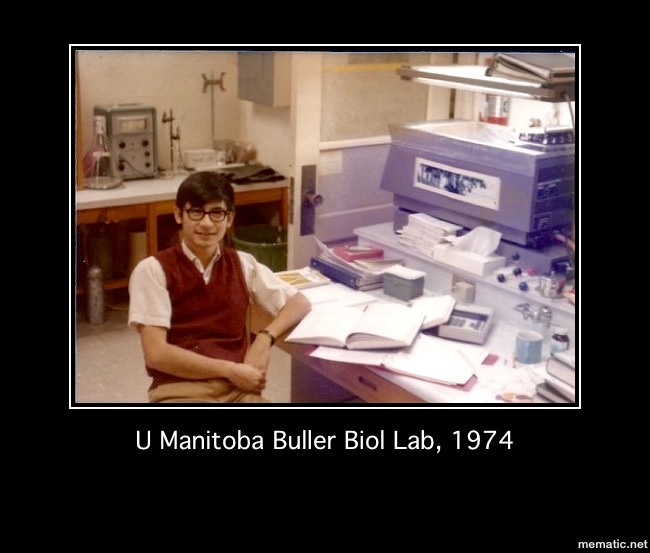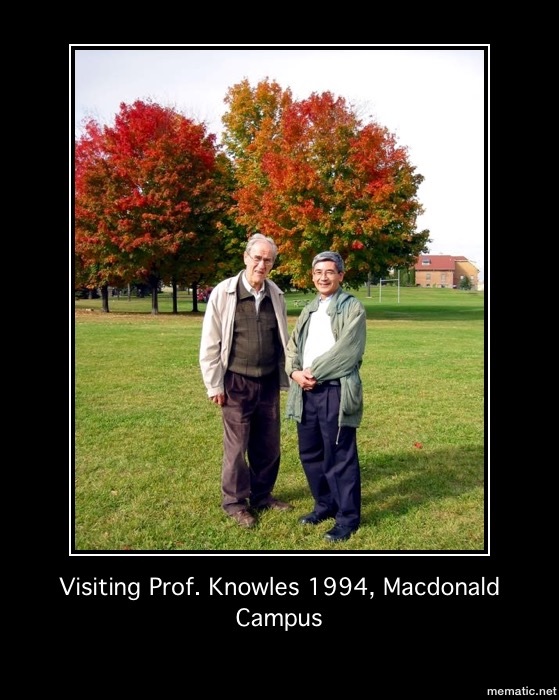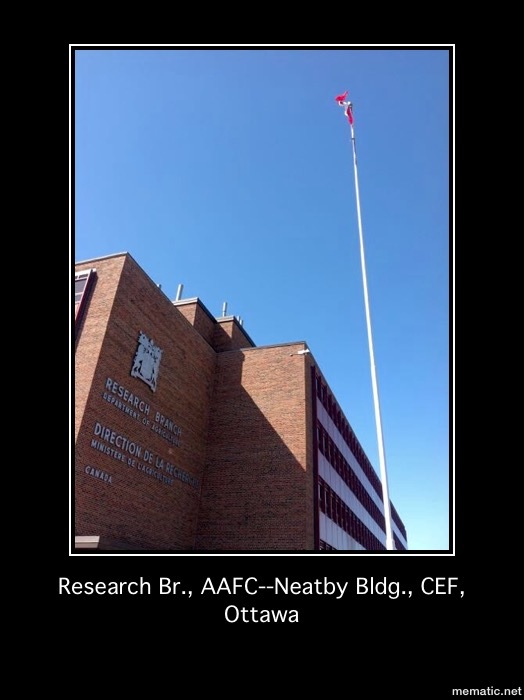Science, Séance and Red Herring
Reflections on a life in microbial science
Early and late Canadian life
Two historical world events dominated international news in the mid 1960s as the Vietnam War was at its peak, and the tsunami of the Chinese Cultural Revolution was rippling into Hong Kong. The latter’s violent mass movement was sending Mainland Chinese youths and liberal intellectuals into an odyssey. Shortly afterwards, like several of my innocent Wah Yan classmates, I plunged into Winnipeg in this great north from the subtropical climate in Hong Kong to pursue post-secondary studies after matriculation. Unlike most of my matriculation science classmates, I had no intention or interest to enter medical school. Since then, living in Canada has been offering me the taste of changing seasons as musically painted in Vivaldi's four violin concerti. Perhaps, variety is the spice of life that embellishes it with brilliance and colours.
My university years were dotted by few thought-provoking events. One of them was the visit of the social activist David Suzuki, who had started his broadcasting career on nature and the environment, and gave a well-received public lecture at the student union of the University of Manitoba (UM). My awakening really was initiated after I had naïvely decided to go into graduate school in microbiology without considering employment prospects or seeking career counselling. But then, more time was freed up for me to explore science, liberal arts and humanities on my own, besides developing an experimental research career. Experimental research is a demanding undertaking, which I did not recognize at the time. Nevertheless, it had been an interesting, worthwhile and rewarding endeavour. In the following reminiscences I shall explain why.
 After twenty-eight formative years, the roles I had played in the thirty-four years that followed carved the perspectives that might indicate what is already in store. My retirement from the Canadian agriculture department as a research scientist started three years ago, when it was three weeks into the dead of winter. Some say to retire is like living on golden pond; others, a flaming candle that is flickering to burn out. Both are true aspects of retirement, marking another milestone of a sojourn on earth. Perhaps, like the Lunar New Year, which falls in mid winter, it gives one hope for further awakenings and renewals. My role is continuing to evolve now, allowing me more time and choices to harvest the fruits of life.
After twenty-eight formative years, the roles I had played in the thirty-four years that followed carved the perspectives that might indicate what is already in store. My retirement from the Canadian agriculture department as a research scientist started three years ago, when it was three weeks into the dead of winter. Some say to retire is like living on golden pond; others, a flaming candle that is flickering to burn out. Both are true aspects of retirement, marking another milestone of a sojourn on earth. Perhaps, like the Lunar New Year, which falls in mid winter, it gives one hope for further awakenings and renewals. My role is continuing to evolve now, allowing me more time and choices to harvest the fruits of life.
Microbiology, limnology and the Canadian Shield
Microbiology is usually introduced as a second-year university course. Other than science students, nursing, pre-med, food science and some agriculture students also take it as a requisite for their careers. The life science of microbiology is broad and diverse. Mostly invisible to the naked eye, microbes are distributed in the three kingdoms Eukarya, Bacteria and Archaea of all living organisms. However some fungi, which belong to the Eukarya kingdom, such as moulds and mildews, respectively, can be seen growing on stale bread and over-watered plants without a microscope. Mushrooms are also large fungi as they have membrane-bound nuclei. Microbes and their interactions with the environment on various substrates, including both external and internal surfaces of other organisms, are studied in environmental microbiology. Microbial ecology is concerned with such studies in certain ecosystems, natural (soil, water) or artificial (sewage lagoon, fermentation vessels).
In the late 1960s the U.S.A. and Canada established an international joint commission for Great Lakes studies in response to rampant algal blooms that choked aquatic life and generated fowl smell when the algae died off. This phenomenon of eutrophication (algal overgrowth due to overloading of nutrients and minerals into aquatic environments) was caused by agricultural runoffs that contained nitrogen (N) fertilizers and the phosphorus (P) used as detergent builder. The use of P as detergent builder was subsequently banned. For proper natural water management, a vast area in the Canadian Shield comprising more than fifty pristine lakes of various sizes, located in northwestern Ontario near the town of Kenora, was chosen for long-term studies. Accessible by logging roads, it was designated the Experimental Lakes Area (ELA) as a unique setup for studying hydrology and the effects of nutrient loading into aquatic systems. It was under the jurisdiction of the Canadian federal department of Fisheries and Oceans, and was managed by the Freshwater Institute located on the UM campus. The onsite research station and trailer camp director was David Schindler, an environmental biologist, Rhodes scholar and scuba diver. Still active and outspoken, he currently is a professor emeritus at the University of Alberta.
When I was accepted by UM into grad school in the microbiology department and offered a fellowship, my supervisor, Norman Campbell, Associate Dean of Science, was a research grantee for the study of N cycling at ELA. I was assigned to determine the gaseous N loss rate during the summer season in Lake 227, a small (surface area of 5 hectares) artificially polluted lake in the Canadian Shield. Bacteria mainly mediate this anaerobic N loss process, known as denitrification in the biological N cycle, which we have studied in high school. It is a means by which certain bacteria can “breathe” in the absence of oxygen but with nitrate to generate energy for their metabolism. Another graduate student undertook the task of assaying the contribution of blue-green bacteria (Cyanobacteria) to N input into the lake by dinitrogen (N2 or gaseousN) fixation; a third graduate student (John Rudd), who was supervised by Bob Hamilton of the Freshwater Institute, investigated methane oxidation in the same lake as a carbon (C) sink. These projects were parts of a program to estimate the lake’s C and N budgets for managing nutrient loading to avoid eutrophication. Since I had no knowledge of the freshwater environment, I was recommended to audit a limnology course, the study of freshwater and brackish water as opposed to oceanography, which is the study of seawater. Hence, my discipline was further specialized in aquatic or lacustrine microbiology, a subject I had never heard of in my undergrad years.
research grantee for the study of N cycling at ELA. I was assigned to determine the gaseous N loss rate during the summer season in Lake 227, a small (surface area of 5 hectares) artificially polluted lake in the Canadian Shield. Bacteria mainly mediate this anaerobic N loss process, known as denitrification in the biological N cycle, which we have studied in high school. It is a means by which certain bacteria can “breathe” in the absence of oxygen but with nitrate to generate energy for their metabolism. Another graduate student undertook the task of assaying the contribution of blue-green bacteria (Cyanobacteria) to N input into the lake by dinitrogen (N2 or gaseousN) fixation; a third graduate student (John Rudd), who was supervised by Bob Hamilton of the Freshwater Institute, investigated methane oxidation in the same lake as a carbon (C) sink. These projects were parts of a program to estimate the lake’s C and N budgets for managing nutrient loading to avoid eutrophication. Since I had no knowledge of the freshwater environment, I was recommended to audit a limnology course, the study of freshwater and brackish water as opposed to oceanography, which is the study of seawater. Hence, my discipline was further specialized in aquatic or lacustrine microbiology, a subject I had never heard of in my undergrad years.
No simple method was then available to measure microbial denitrification directly in the lake system. An in situ study, i.e. on-site experimental setup to closer simulate natural environmental conditions, was preferred. Summer fieldwork requiring staying at the ELA research station was expected. Before fieldwork, however, a method had to be developed and a protocol designed to measure dissolved N2 gas in lake water. Dr. Campbell suggested using an N-15 (15N) stable isotope-tracer technique as the approach, which demanded gas analysis by mass spectrometry. He also advised me to include a new chemical inhibitor, Nitrapyrin, to eliminate an interfering activity (nitrification) affecting denitrification rate measurements. At times, he let me read and comment on relevant manuscripts submitted for publication in scientific journals, for which he was invited to review and give recommendations. Thus, I learned how to offer objective and constructive criticisms after thorough comprehension and analysis of the submission.
After consultation with Dr. Betts of the chemistry department at UM, I devised a gas partition and equilibration procedure for extracting dissolved gas from water samples for 15N analysis. The gas sample preparation for mass spectrometry analysis required elaborate processing, and a glassblower was commissioned to build a special vacuum rack for the preparative procedure. After a few months, the method showed promise and was tested successfully. The reward was my first scientific publication three years before I completed all my doctorate requirements. This was my first taste of satisfaction from working in science.
By this time, I had completed the required course work in advanced microbiology and biochemistry, and passed an oral comprehensive examination. This allowed me to collect more data from summer fieldwork. For these investigations, I got to supervise an undergrad summer student assistant to help looking after the laboratory on campus while I was on field trips.
Summer fieldwork was not all work and no play. It actually enriched my outdoor activities over my experience as a junior boy scout in Wah Yan’s 11th Kowloon Troop. I liked driving a half-ton truck with my gears, sometimes by myself, from Winnipeg via Kenora to ELA. Off the highway, the logging road needed some negotiation skill as it could be washed out at times by heavy rain, and a logging truck might appear just around a turn. After a forest fire nearby, one could smell the remnant smoke in the air. Breaking the natural tranquility and somewhat ghastly silence, a forlorn loon could also be heard at a distance. Such was the imagery of Canadian wilderness. Occasionally, I also rode a trail motorbike to pick up an outboard motorboat for accessing the field site of my experimental lake, Lake 227. Finally, a short hike led to the experimental lakeshore. I remember a startling encounter with a snapping turtle on one of such hikes, but luckily, instead of running into a black bear on the foot trail.
I went on a memorable canoe trip while working there over one long weekend. Several athletic American graduate students from Columbia University kindly invited me to join this outing. As I did not have their robust body build or strength, I was spared the labour of portaging the canoe over meandering trails between lakes. Most impressive was the dark night sky dotted by bright twinkling and shooting stars.
Three summers’ fieldwork had given me enough data to compute and analyse results of denitrification rates, and draw significant conclusions. In addition, phytoplankton or algal uptake of nitrate was also briefly examined. I then finished drafting my thesis and took a break for my first visit home, nine years after I left Hong Kong.
Post-doctoral years—“urbanized fieldwork”
My thesis defence came and went uneventfully as the examiners were kind to me. Friends held a traditional post-exam faculty celebration. What to do then was to land on some post-doctoral track as a professional scientist trainee for independent research. Freedom from formal schooling, I thought, was finally attained because I no long would be subjected to regimental examinations.
Roger Knowles was my external thesis examiner. An English gentleman and well-respected microbiology professor at the Macdonald Campus of McGill University, where the Agriculture Faculty situated, he was a kind man who produced many outstanding students internationally and across Canada. In fact the first Canadian university microbiology department was established on the Macdonald Campus by a few pioneering microbiologists from the other side of the Atlantic. Roger soon offered me a postdoctoral fellowship in his laboratory as he was building up his research in denitrification. Dr. Campbell was delighted and highly recommended me to accept the offer. Then to Sainte Anne de Bellevue off I went around Easter 1977, skipping the convocation ceremonies. As I had no need for the diploma, I sent it home for my parents who treasured it more than I. Dr. Campbell once told me that the degree was a union card, which I would need to work even in academia.
the Agriculture Faculty situated, he was a kind man who produced many outstanding students internationally and across Canada. In fact the first Canadian university microbiology department was established on the Macdonald Campus by a few pioneering microbiologists from the other side of the Atlantic. Roger soon offered me a postdoctoral fellowship in his laboratory as he was building up his research in denitrification. Dr. Campbell was delighted and highly recommended me to accept the offer. Then to Sainte Anne de Bellevue off I went around Easter 1977, skipping the convocation ceremonies. As I had no need for the diploma, I sent it home for my parents who treasured it more than I. Dr. Campbell once told me that the degree was a union card, which I would need to work even in academia.
Ste. Anne de Belleview was a rustic little town on the west side of Montreal Island. The Macdonald Campus was named after the benevolent contributor of the Macdonald Tobacco Company. The campus was also shared with Sir John Abbot College, an English pre-university school known as a CEGEP in the Quebec public education system. Promoted to a post-doc salary, I was able to rent a bachelor apartment on a quiet street on the west edge of the campus. There, my independent professional life began. It was also then that I became a naturalized Canadian.
I enjoyed the natural environs of Ste. Anne, where I could relax in the weekends. I cycled on campus paths, in the experimental fields as well as in the town or the arboretum of Macdonald College. The arboretum even had an abandoned sugar shack, which was once used for making maple syrup. Occasionally, I went into the metropolis by bus to explore its downtown shopping areas, which were connected by underground tunnels from one building to another.
Fieldwork then was switched to an irrigation pond and the cornfield to assay N loss via denitrification. There was an opportunity to board a research vessel of the Canadian Centre of Inland Waters (later renamed National Water Research Institute) at Burlington, Ontario, for a survey of N2O distribution in Lake Erie. At that time, denitrification was discovered in a few free-living N2-fixing bacteria. Roger became interested to investigate this process in Azospirillum brasilense, a free-living N2 fixer first found associated with sugarcane plants in Brazil. The research was facilitated by Roger’s discovery that acetylene could be used separately to assay denitrification in addition to N2 fixation. This was an independent discovery, which was concurrently reported by Jim Tiedje of the Michigan State University. As this work was a physiological study in relation to hydrogen (H2) metabolism, the experiments involved were done in the laboratory with bacterial cultures. Subsequently, fieldwork was no longer continued.
It appeared to be an intriguing question as to why the same bacterium could fix N2 as well as denitrify. The two processes were known to keep the N cycle in equilibrium, generally stabilizing the N2 content of the atmosphere at 79%. A side effect of denitrification was also known. It generated nitrous oxide (N2O, a greenhouse gas) if not further reduced to N2.
Two years passed at Macdonald College in which I gained experience in conducting experiments in bacterial physiology. It prepared me to take up a research associate position at the University of Nebraska-Lincoln (UNL) to investigate the biochemistry of N assimilation in soybean root nodules, which were formed by the rhizobia in symbiosis with the plant. Robert Klucas, my supervisor and student of Harold Evans at Oregon State University, was a down-to-earth gentleman who applied his skill in enzymology to investigate soybean nodule N metabolism. UNL had great greenhouse facilities for growing experimental plants. I was introduced to greenhouse cultivation of soybean as potted plants, from which crude enzymes were prepared and fractionated from soybean nodule extracts. It was some different kind of tedious and meticulous work, which I had not experienced before, especially involving the isolation and purification of mitochondria from the nodules. For this project, the objective was to confirm a previously unknown pathway of N assimilation after N2 was fixed to ammonia in the nodules.
As it was prudent not to overstay in the U.S.A. to jeopardize my Canadian connections, I left UNL after one year and landed briefly at the Biological Sciences Division of the National Research Council in Ottawa as an assistant research officer. I got married that year and before long, I successfully competed for an indeterminate Research Scientist position at the Central Experimental Farm (CEF) of the federal agriculture department, Agriculture Canada. My research career as an independent principal researcher thus began.
National Research Council in Ottawa as an assistant research officer. I got married that year and before long, I successfully competed for an indeterminate Research Scientist position at the Central Experimental Farm (CEF) of the federal agriculture department, Agriculture Canada. My research career as an independent principal researcher thus began.

